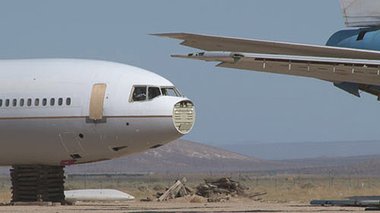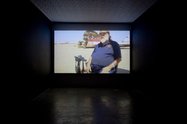John Hurrell – 28 December, 2009
The challenge for the visitor is to also figure out how the three interact collectively. Do they link up? If so, how?
Auckland
12 December 2009 - 27 February 2010.
Richard Maloy
Raw Attempts
Campbell Patterson
Floorshow
Hito Steyerl
After the Crash
ARTSPACE’s director, Emma Bugden, has organised a trio of related exhibitions for 2009’s last slot, presentations that explore processes of continual change and transmutation. Each of the three artists has a project that is engaging in isolation, and the shows can thus be approached separately, but the challenge for the visitor is to also figure out how the three interact collectively. Do they link up? If so, how?
Firstly, looking at the three solo components, the most dramatic is Richard Maloy’s use of the big square ARTSPACE gallery. Maloy is known for his series of photos and videos where he either applied chunks of gooey butter to his head and face, using his physiognomy as an armature, or lumps of sticky wet clay to his torso and arms - to be smoothed over and incorporated as an extension of his body.
For ARTSPACE Maloy starts by treating the ceiling of the gallery the way he used to treat his body, but with cardboard not clay. It functions as a armature/support, not a surface on which to rest or lean things but a plane to which they can be attached, that supports all their weight. Working at night or in daylight hours when the gallery is shut, he uses a staple gun with which he can fasten opened out and dismembered cardboard boxes, later painted orange.
His first experiment was a huge continually spiralling wall, a thin wonky shell designed like a massive orange peeling – held up by the roof. If you look at the long sequence of online photos here you will see where he has tested other structures too, letting some fall down by overloading or else deliberately pulling them down – only to try hanging up something new. Each time, fastening forms to the ceiling and working his way down by adding to each suspended sheet with sticky tape, or else using the floor to reconfigure the fragile walls when collapsed, to see what shapes can hold up their own weight when folded or buckled around.
Campbell Patterson has used the long narrow gallery to display initially six, now five, projections on the walls. He films his body as he carries out various tasks that often set out the spatial limitations of each site. The dozen or so actions you see him perform include using no hands but soaping his head by rubbing it into a mound of aerosol foam sprayed on the floor, pulling a camera attached to string towards his face by chewing up and ingesting the string, turning another camera with another piece of string as he moves around a small bathroom with a shower going that soaks his clothing, crawling along a tiled floor by dragging the tripod and filming camera behind him, licking up swept dirt or soap powder from piles on the floor, mashing up bananas with his stockinged feet, squeezing through a ventilation shute, and lying on the floor with a pointed stone under his belly.
Of the three Patterson show I’ve seen in Auckland so far, this presentation is the most successful, due to the restricted focus of his material and its self-deprecating humour – despite its knowing art historical references to sixties performance art.
These two Auckland artists specialise in working within specially devised rules, difficult restrictions put in place to shape the form of their projects – vaguely related to the early (pre-performance) poems of Mike Parr and Vito Acconci in the sixties and seventies, or European Oulipo writers like Georges Perec, or Raymond Queneau.
In After the Crash, Hito Steyerl’s film, when placed in this ARTSPACE context, presents dismantled airplanes in an aircraft junkyard in the Californian desert as a metaphor for a morgue with human bodies, with their recyclable parts as tropes for human organs. Though critiquing capitalism and its recent collapse it also marvels as how such an ethos survives, how even discarded waste can be swiftly turned into substantial profit - through being made into exploding film props. The mutilated skeletal aircraft parts however radiate poignancy, part of an ongoing process that parallels those of Patterson and Maloy in terms of inventiveness.
Though Steyerl’s film is quite different to the projects of Patterson and Maloy, and about documented process, not improvised or procedural events, as Bugden puts it ‘the planes take on an oddly human subjectivity.’ The inclusion of this German-based artist is important because of that, as an inverse foil to some of the machinelike, relentlessly unwavering and obsessive aspects of the two highly energetic Aucklanders. A thoughtfully clever package.
John Hurrell






 Two Rooms presents a program of residencies and projects
Two Rooms presents a program of residencies and projects Advertising in this column
Advertising in this column



This Discussion has 0 comments.
Comment
Participate
Register to Participate.
Sign in
Sign in to an existing account.